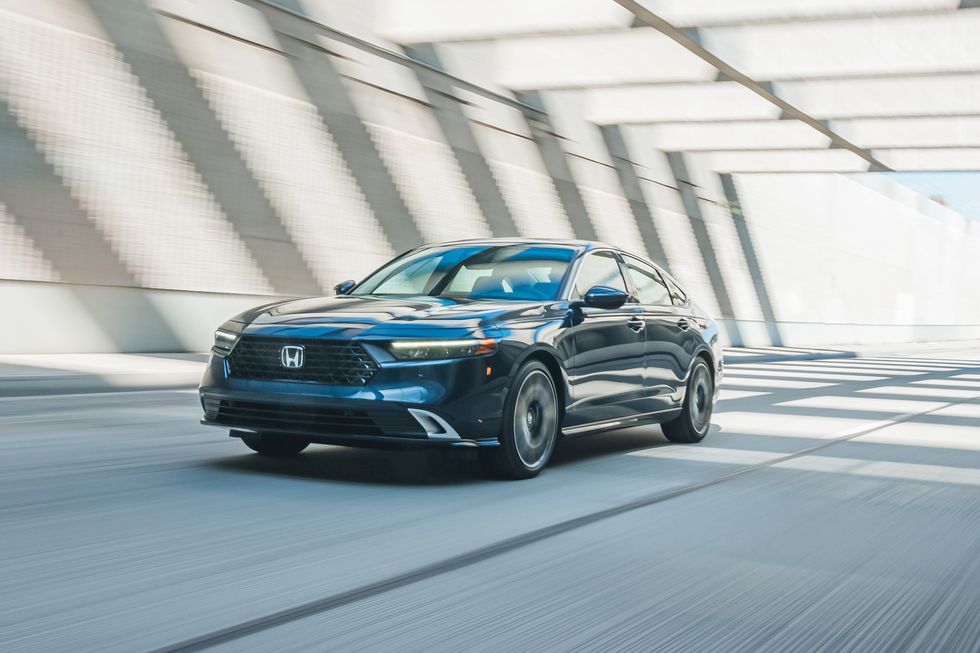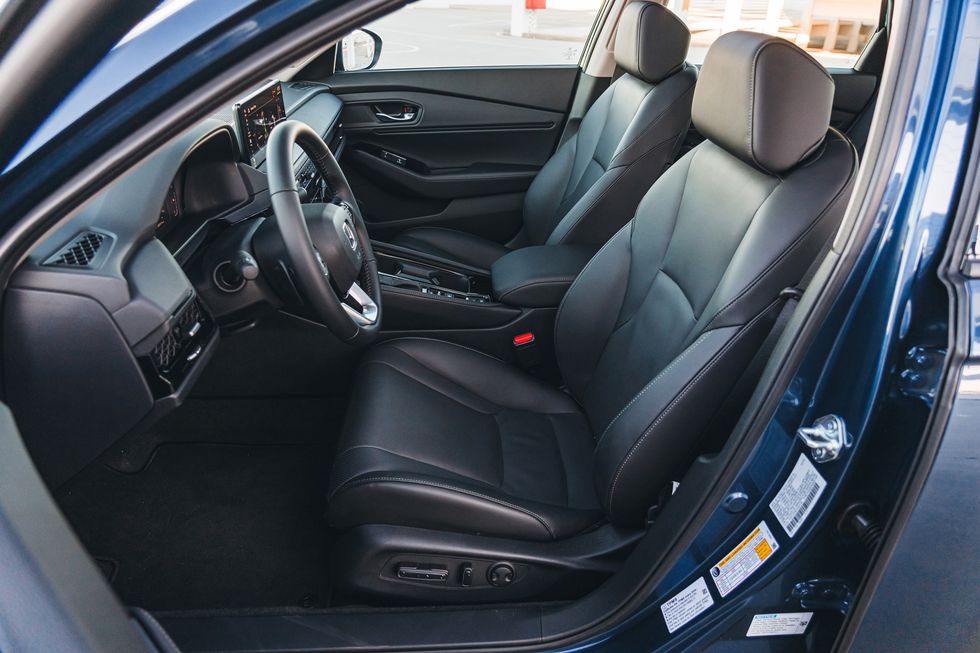From the April 2023 issue of Car and Driver.
To say we’re sad that
Honda dropped the Accord’s previously optional turbo 2.0-liter four from the new 11th-generation model—only a few short years after it axed the nameplate’s manual transmissions—is an understatement. One of our favorite models is in danger of losing its mojo. While low take rates are largely to blame for those calls, history offers additional context: Satisfying sensibleness, not heady acceleration, has been the driver of the Accord’s success over the past 47 years, 37 of which have seen an Accord on our 10Best list. Fast-forward to today’s dwindling sedan market and looming emissions regulations, and the Accord’s survival depends on electrification playing a much greater role.
You can still get a standard gas powertrain—a 192-hp turbo 1.5-liter four mated to a CVT—in the lowest Accord trims, which open at $28,390. But all mid- and upper-range models, from the $32,990 Sport to our $38,985 Touring test car, now feature Honda’s updated hybrid system, which is much like the one found in the latest CR-V. A novel design with essentially no transmission, this setup combines a 146-hp Atkinson-cycle 2.0-liter four-cylinder, a 1.1-kWh battery pack, and two clutched electric motors, one spun by the engine as a generator and the other providing power to the ground. Combined output is 204 horsepower, a gain of two horses over the outgoing hybrid.
As before, electrons primarily motivate the Accord hybrid below 20 mph and during brief intervals of low-load cruising. Heavier lifting necessitates the input of the revised gas engine. It’s better insulated, which helped cut three decibels from our interior sound readings at full throttle. Under certain conditions at moderate loads, such as on the highway, the four-cylinder also can be clutched in to power the wheels directly. From the driver’s seat, this all comes together seamlessly. Though the four-banger still sounds a bit grainy when working hard, any droning is short-lived, thanks in part to simulated “shifts” that change the engine’s pitch yet don’t affect the car’s forward progress. The uninitiated likely won’t even notice the gas-electric wizardry.
At full tilt, acceleration is more deliberate than rapid, despite the easy highway merges provided by the traction motor’s instant 181 horsepower and 247 pound-feet of torque. Compared with the last Accords we tested, our example’s 6.6-second run to 60 mph is a half-second quicker than the previous hybrid’s and 0.6 second quicker than the last 1.5T but still a far cry from the 252-hp 2.0T version’s 5.4 seconds. More grunt and a larger battery would quicken our pulse, though the Accord’s still-reasonable ask and 3503-pound curb weight—already 56 pounds heavier than before—would surely suffer.
The important stuff comes when you forget about the hybrid bits and just drive. The new car’s helm feels as light and reassuringly precise as ever, and its firm brake pedal beautifully blends friction and regenerative systems. Though the body is 2.7 inches longer, most dimensions carry over, save for a rear track that’s up to 0.4 inch wider. Its structure is also stiffer than before. Along with minor suspension tweaks and revised bushings, this family sedan tracks around corners with a grace that even its 0.88 g of grip and 173-foot stop from 70 mph—solid results from modest all-season tires—fail to suggest. Hit a challenging road, and body motions remain military-school disciplined, yet the ride never approaches harsh—qualities rarely found together even in heavier, higher-riding SUVs. Honda even managed to preserve the Accord’s massive 17-cubic-foot trunk.
Also un-SUV-like: EPA combined estimates of 44 mpg for most models, on 19-inch wheels, and 48 mpg for the EX-L trim on its 17s (nonhybrids earn a 32-mpg combined rating). We couldn’t perform our 75-mph highway test, but we did average a strong 43 mpg over more than 1000 miles of Southern California byways, suburban sprawl, and demanding mountain roads. Six levels of regen, from virtually none to near one-pedal operation, are adjustable via paddles on the steering wheel, helping the car manage speed and quickly recoup energy. In addition, activating Sport mode (there also are Normal, Eco, and Individual settings) sharpens the powertrain’s responses and will engage the four-cylinder for engine braking on steep descents, which we found more useful than the heftier steering action and augmented engine sounds it also adds.
With its longer hood and fastback profile, the new Accord cuts a handsome figure, particularly on its bigger wheels. Minimalist detailing leaves it somewhat unadorned from certain angles, but we dig it. The same goes for the refined interior and its thoughtful enhancements, including a smidge more legroom (now 40.8 inches) for the already generous back seat and the replacement of Honda’s unintuitive shift buttons with a simple PRND lever on the console. New front chairs held us snug in all-day comfort, while straight-forward ergonomics and attractive details, such as the dash-spanning mesh trim that conceals the climate vents, appeased our senses. A standard suite of driver aids keeps watch, and the Touring trim bolsters the feature count with a head-up display, a premium Bose stereo, wireless device charging, front-seat ventilation, and heated rear seats.
Sensible also applies to this Accord’s approach to technology, in that its interface is designed to mirror a user’s phone apps, including for navigation. All models get a crisp 10.2-inch digital instrument cluster, and hybrids sport a 12.3-inch center touchscreen with wireless Android Auto and Apple CarPlay (the standard 7.0-inch unit requires a cord). Thankfully, a volume knob is present, as is a useful hand rest for surfing the infotainment’s simplified menu layout. Stepping up to the Touring also adds Google Built-In with connectivity to the company’s Maps, Assistant, and Play services (three years of unlimited data are included). Although we’re not eager to have the tech giant intrude on our lives any more than it already does, Honda’s integration is refreshingly short of the annoyances that come with many factory systems.
For some, a hybrid powertrain, no matter how well engineered, will never be preferable to pure internal combustion. But even those folks must concede that evolution has been central to the Accord’s longevity. Practical, fun to drive, and a good value, this generation remains true to the Accord mission—and the tenets of our highest award. In becoming a more rational machine, the Accord is now a better fit for the times.
Specifications
Specifications
2023 Honda Accord Touring
Vehicle Type: front-engine, front-motor, front-wheel-drive, 5-passenger, 4-door sedan
PRICE
Base/As Tested: $38,985/$38,985
Options: none
POWERTRAIN
DOHC 16-valve 2.0-liter Atkinson-cycle inline-4, 146 hp, 134 lb-ft + AC motor, 181 hp, 247 lb-ft (combined output: 204 hp, 247 lb-ft; 1.1-kWh lithium-ion battery pack
Transmission: direct-drive
CHASSIS
Suspension, F/R: struts/multilink
Brakes, F/R: 12.3-in vented disc/11.1-in disc
Tires: Michelin Primacy MXM4
235/40R-19 96V M+S DT1
DIMENSIONS
Wheelbase: 111.4 in
Length: 195.7 in
Width: 73.3 in
Height: 57.1 in
Passenger Volume, F/R: 53/50 ft3
Trunk Volume: 17 ft3
Curb Weight: 3503 lb
C/D TEST RESULTS
60 mph: 6.6 sec
1/4-Mile: 15.3 sec @ 90 mph
100 mph: 19.5 sec
Results above omit 1-ft rollout of 0.3 sec.
Rolling Start, 5–60 mph: 8.1 sec
Top Gear, 30–50 mph: 3.7 sec
Top Gear, 50–70 mph: 5.1 sec
Top Speed (gov ltd): 125 mph
Braking, 70–0 mph: 173 ft
Roadholding, 300-ft Skidpad: 0.88 g
C/D FUEL ECONOMY
Observed: 43 mpg
EPA FUEL ECONOMY
Combined/City/Highway: 44/46/41 mpg
Technical Editor
Mike Sutton is an editor, writer, test driver, and general car nerd who has contributed to Car and Driver‘s reverent and irreverent passion for the automobile since 2008. A native Michigander from suburban Detroit, he enjoys the outdoors and complaining about the weather, has an affection for off-road vehicles, and believes in federal protection for naturally aspirated engines.


